We are almost finished with our course!
So now, we are ready to apply all the tools we have developed so far.
This week, we will see how can use code to solve mathematical problems such as,
- Derivate functions.
- Integrate functions (Definited integrals).
- Root searching.
We will use the libraries available on python we have worked on last weeks (NumPy and Matplotlib).
Theory¶
Searching roots of a function is one of the most common problems solved with computers on science. So we are going to learn two of the most widely used methods,
- Bisection
- Newton-Raphson
The method work as follows.
- We select the two points of the interval (the limits).
- Calculate the middle point.
- Calculate the function on the midpont.
- Define the convergence
- The interval is small enough.
- The value of the function on the midpoint is small enough.
- If the criteria are not satisfied, check the signs,
- If $f(a_n)>0$ and $f(p_n)>0$ or $f(a_n)<0$ and $f(p_n)<0$, then the root is now on $(p_n,b_n]$.
- If $f(a_n)<0$ and $f(p_n)>0$ or If $f(a_n)>0$ and $f(p_n)<0$, then the root is now on $(a_n,p_n]$.
- Repeat for the new limits.
Function¶
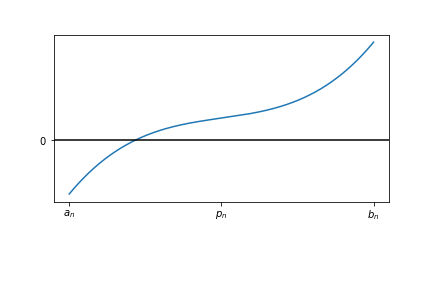
Initial Interval¶
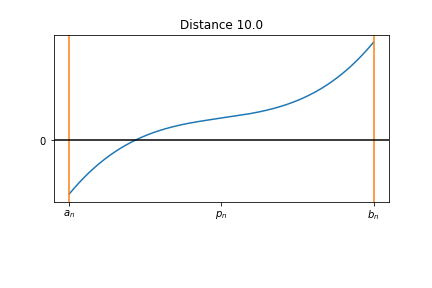
Midpoint¶
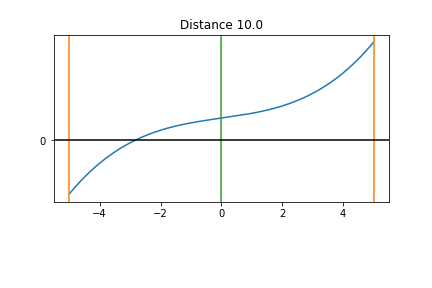
Resize the Interval step 1¶
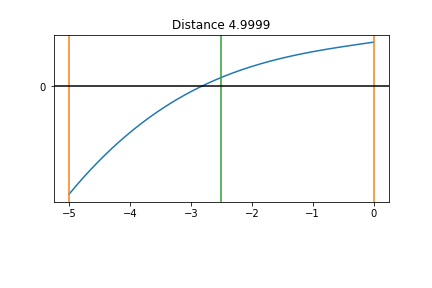
Resize the Interval step 2¶
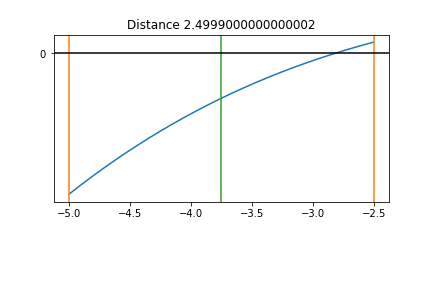
Resize the Interval step 3¶
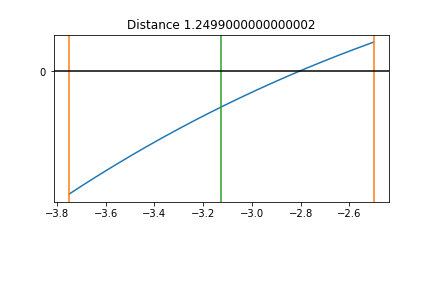
Resize the Interval step 4¶
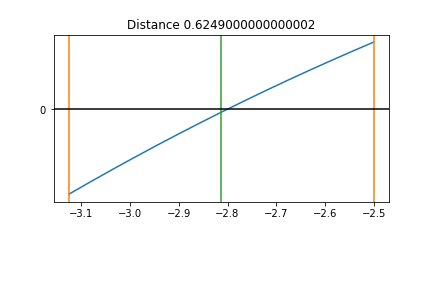
Resize the Interval step 5¶
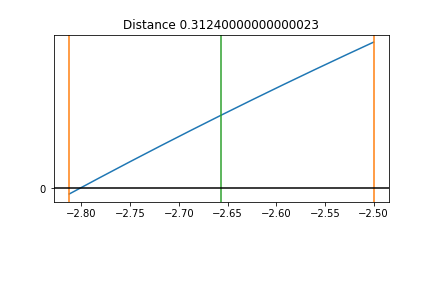
Resize the Interval step 6¶
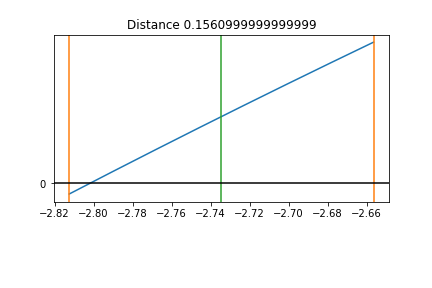
Resize the Interval step 7¶
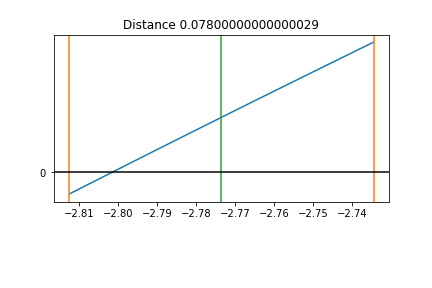
Resize the Interval step 8¶
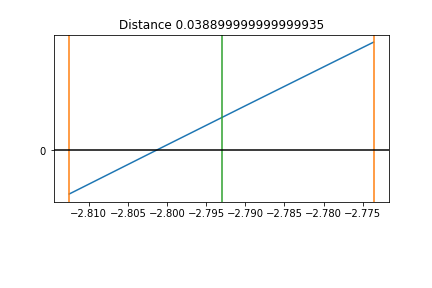
Resize the Interval step 9¶
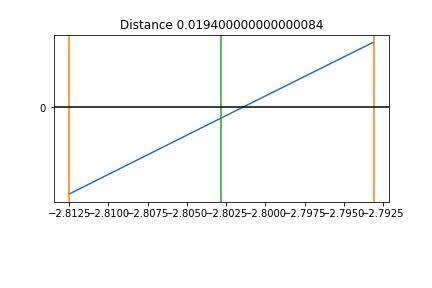
Resize the Interval¶
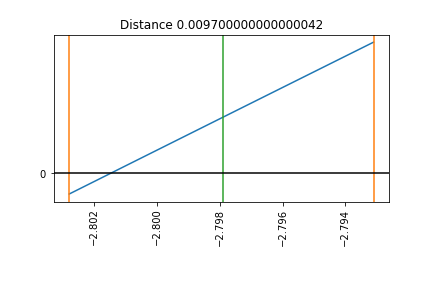
Resize the Interval step 10¶
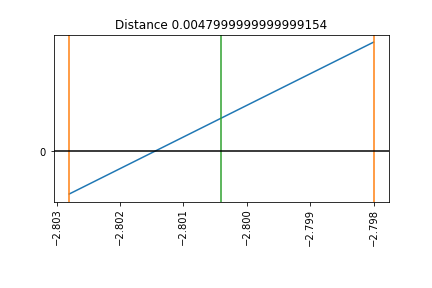
Resize the Interval step 11¶
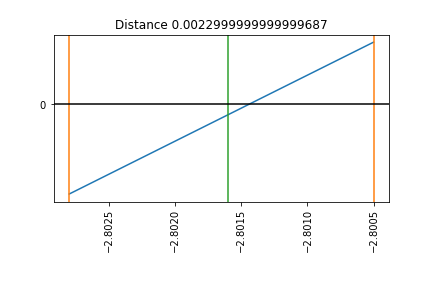
Resize the Interval step 12¶
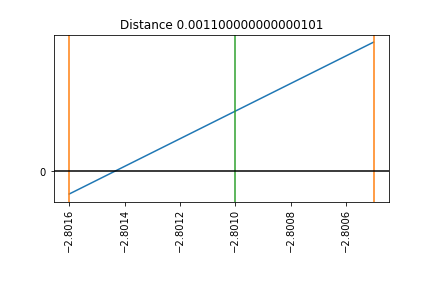
Resize the Interval step 13¶
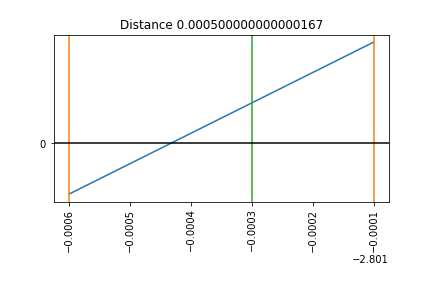
Resize the Interval step 14¶
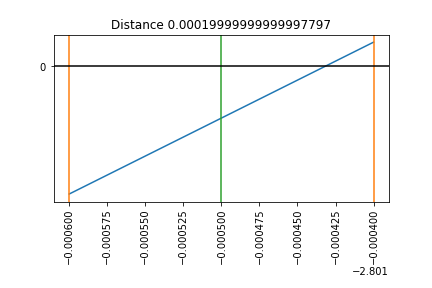
The first problem we will solve, is finding the value of $x$ such that $f(x)=0$ with
$$ f(x)=\left(\tanh\left(\frac{x}{4}\right)+\frac{\cos(x)\sin(x)}{x}\right)^3 $$import numpy as np
import matplotlib.pylab as plt
def f(x):
return (np.tanh(0.25*x)+(np.cos(x)*np.sin(x))/x)**3
x=np.linspace(-10,10,100)
y=f(x)
fig=plt.figure()
ax=fig.add_subplot(111)
ax.plot(x,y)
ax.axhline(0,color='C1')
<matplotlib.lines.Line2D at 0x11921e128>
def bisec(f,an,bn):
eps=1e-10
while (np.abs(an-bn)>eps):
pm=(an+bn)/2.
if (f(an)*f(pm)>0):
an=pm
else:
bn=pm
return pm
print(bisec(f,-10,10.1),f(bisec(f,-10,10.1)))
-1.1908552421034986 1.0627357754887731e-33
The first problem we will solve, is finding the value of $x$ such that $f(x)=0$ with
$$ f(x)=\tanh\left(x-2.1\right)+0.1 $$def f(x0):
return np.tanh(x0-2.1)+0.1
x=np.linspace(-10,10,100)
y=f(x)
fig=plt.figure()
ax=fig.add_subplot(111)
ax.plot(x,y)
ax.axhline(0,color='C1')
<matplotlib.lines.Line2D at 0x1192c7ef0>
print(bisec(f,-10,10.1),f(bisec(f,-10,10.1)))
1.99966465226571 -3.1823571555733565e-12
Newton¶
This method is more complex but precise than the bisection. This is also known as the tangent method, because it starts from a guess and moves as the tangent line.
The method work as follows.
We select an initial guess $p_0$, then the following point is found by taking the zero of the derivative on that point. The equation of that line is $$y=f'(p_0)(x_1-x_0)+f(x_0).$$
So, in order to find the value of $x_1$, $y=0$, that leads to $$ x_{i+1}=x_{i}-\frac{f(x_i)}{f'(x_i)}, $$ and it is repeated until a tolerance. (Or $f(x_i)==0$).
Function¶
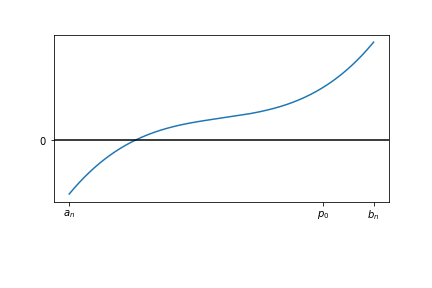
Initial Interval¶
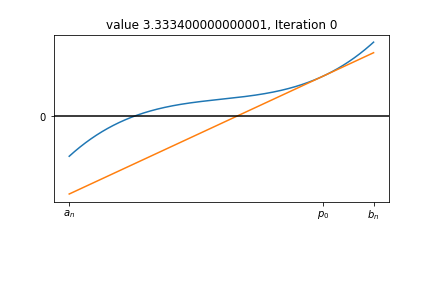
Midpoint¶
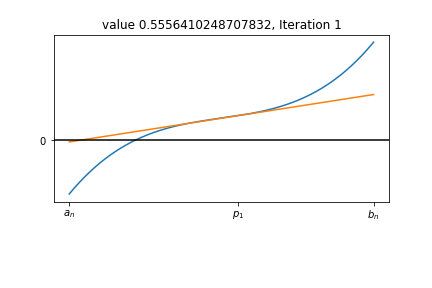
Resize the Interval step 1¶
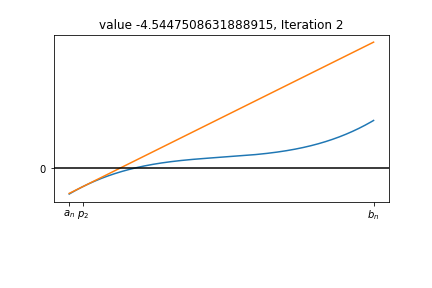
Resize the Interval step 2¶
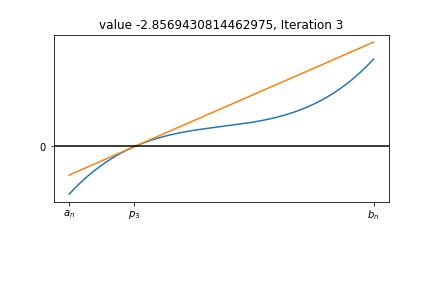
Resize the Interval step 3¶
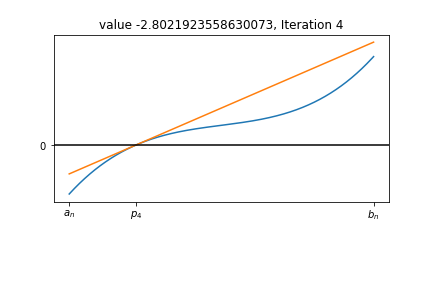
Resize the Interval step 4¶
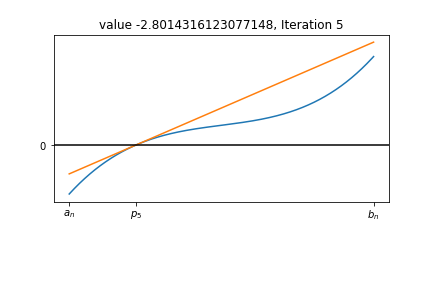
Resize the Interval step 5¶
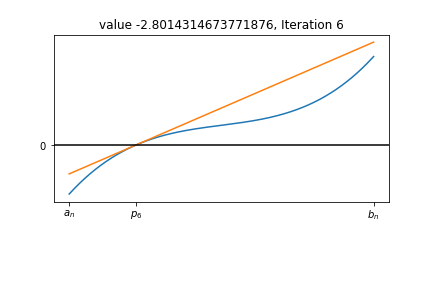
Resize the Interval step 6¶
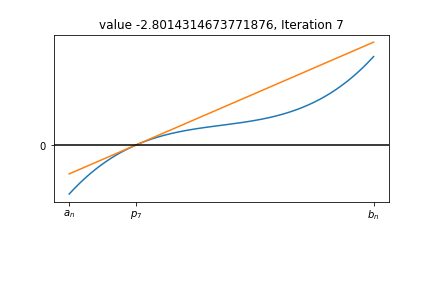
Resize the Interval step 7¶
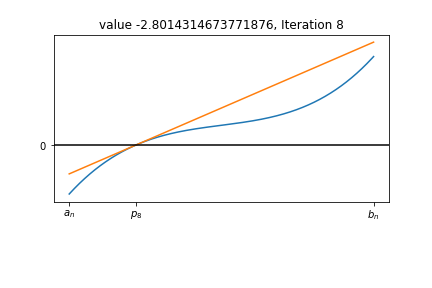
def Newton(f0,df0,xi):
eps=1e-10
while np.abs(f0(xi))>eps:
xi-=f0(xi)/df0(xi)
return xi
Again the first function we are testing
$$ f(x)=\left(\tanh\left(\frac{x}{4}\right)+\frac{\cos(x)\sin(x)}{x}\right)^3 $$def f(x):
return (np.tanh(0.25*x)+(np.cos(x)*np.sin(x))/x)**3
x=np.linspace(-10,10,100)
y=f(x)
fig=plt.figure()
ax=fig.add_subplot(111)
ax.plot(x,y)
ax.axhline(0,color='C1')
<matplotlib.lines.Line2D at 0x1193a4b70>
def df(x):
return (0.75/x**4)*((x*np.tanh(0.25*x)+
np.sin(x)*np.cos(x))**2.)*(x*x*(np.cosh(0.25*x))**-2.
-4*x*np.sin(x)**2+4*x*np.cos(x)**2.-4*np.cos(x)*np.sin(x))
print(bisec(f,-10,10.1),Newton(f,df,0.5))
-1.1908552421034986 -1.1911507242488286
def f1(x0):
return np.tanh(x0-2.1)+0.1
def df1(x0):
return 1./np.cosh(x0-2.1)**2.
x=np.linspace(-10,10,100)
y=f1(x)
fig=plt.figure()
ax=fig.add_subplot(111)
ax.plot(x,y)
ax.axhline(0,color='C1')
<matplotlib.lines.Line2D at 0x119409630>
print(bisec(f1,-10,10.1),Newton(f1,df1,1.5))
1.99966465226571 1.9996646522689245
But, what if we consider a different initial condition?
print(bisec(f1,-10,10.1),Newton(f1,df1,10.0))
1.99966465226571 nan
/usr/local/lib/python3.7/site-packages/ipykernel_launcher.py:4: RuntimeWarning: overflow encountered in cosh after removing the cwd from sys.path. /usr/local/lib/python3.7/site-packages/ipykernel_launcher.py:4: RuntimeWarning: divide by zero encountered in double_scalars after removing the cwd from sys.path. /usr/local/lib/python3.7/site-packages/ipykernel_launcher.py:4: RuntimeWarning: invalid value encountered in double_scalars after removing the cwd from sys.path.